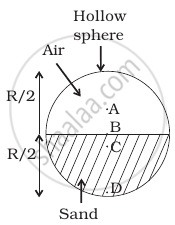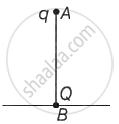Advertisements
Advertisements
Question
For which of the following does the centre of mass lie outside the body?
Options
A pencil
A shotput
A dice
A bangle
Solution
A bangle
Explanation:
The Center of mass of a system (body) is a point that moves as though all the mass were concentrated there and all external forces were applied there.
Important points about the center of Mass:
(i) The position of center of mass is independent of the coordinate system chosen.
(ii) The position of center of mass depends upon the shape of the body and the distribution of mass.
Example: The center of mass of a circular disc is within the material of the body while that of a circular ring is outside the material of the body.
(iii) We can imagine a rigid body also as a system of masses and hence every rigid body has a center of mass. In the case of a regularly shaped uniform rigid body, center of mass is simply the geometric centre of the body.
A bangle is in the form of a ring as shown in the diagram below. We know that the position of center of mass depends upon the shape of the body and the distribution of mass. So, out of four given bodies, the centre of mass lies at the centre, which is outside the body (boundary) whereas in all other three bodies it lies within the body because they are completely solid.

APPEARS IN
RELATED QUESTIONS
A child sits stationary at one end of a long trolley moving uniformly with a speed V on a smooth horizontal floor. If the child gets up and runs about on the trolley in any manner, what is the speed of the CM of the (trolley + child) system?
If all the particle of a system lie in a cube, is it necessary that the centre of mass be in the cube?
Consider a gravity-free hall in which a tray of mass M, carrying a cubical block of ice of mass m and edge L, is at rest in the middle. If the ice melts, by what distance does the centre of mass of "the tray plus the ice" system descend?

Define centre of mass.
Find out the centre of mass for the given geometrical structures.
a) Equilateral triangle
b) Cylinder
c) Square
The centre of mass of a system of two particles divides the distance between them ______.
Which of the following has maximum momentum?
Which of the following points is the likely position of the centre of mass of the system shown in figure?

The mass per unit length of a non-uniform rod of length L varies as m = λx where λ is constant. The centre of mass of the rod will be at ______.
A point charge Q is situated at point B on the ground. A point charge q of mass m is vertically dropped along line AB from a multi-storey building of height h. Find the position of the point charge q when it is in equilibrium.

